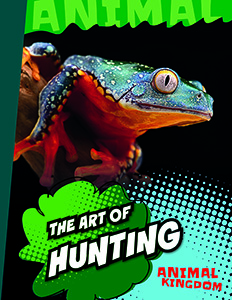Animal Kingdom


Have you ever heard of bower building birds? Underwater "crop circles?" Whales singing arias? Possibly about dancing spiders, or gender-changing fish? Not yet? In that case, it's time to get to know them! In Natural Born Artists, you may encounter the greatest master architects, singers, dancers and circus performers of the animal kingdom, possessing astonishing talents, and goofballs devoted to strange "fashions." You can catch a glimpse of their masterfully constructed homes, gain a sample of their abilities and habits, even witness spectacles that are only rarely seen by human eyes! And the list is not yet complete!
The second volume of the Masters of the Animal Kingdom series escorts the young reader to various points on our Earth through the presentation of astonishing creations, fascinating performances and spectacular costumes. The variety of animal behaviors is displayed through the most exciting examples, while encouraging a respect and continued study of the living world.

"Do you want to survive? Eat, then!" States one of the most simple, most fundamental laws of the animal kingdom. "But how do we get what we desire?" the animals ask. "First, evaluate your abilities! If nature equipped you with weapons suited for the hunt, or with fast movement, you might become an excellent predator. If you happen to fall short of these, employ other tricks: Camouflage yourself, set a trap, or steal morsels from the "plates" of others. And what can one do if the "all you can eat" buffet has been depleted? "Well, yes, at such a time it is a good idea to have reserves... but if you are not too lazy to migrate, perhaps you won't go hungry then, either. If you are skilful, careful and lucky enough, then you can avoid becoming prey for others..."
Volume 3 of the Masters of the Animal Kingdom series circumnavigates every trick of hunting, fishing and gathering, while teaching the reader the dominant, typical, exceptional or special feeding habits of the animal kingdom.

The laws of the wild are ruthless. The strong crush the weak, the hunter swoops down on prey, frost traps, icy-cold freezes, the rays of the sun at the equator sear. In spite of the tough conditions, animal species survive. You can learn how the Himalayan jumping spider survives the high mountain climate, the meerkat the attack of the martial eagle, the marmot a fast that lasts for months, and the tardigrade and the agile frog the act of playing dead.
The 4th volume of the Masters of the Animal Kingdom series reviews necessary, spectacular methods of survival, including ones to avoid enemies, obtaining food and safely raising offpsring. It introduces artists that adapt to dangerous places and those that avoid the roughest weather by hybernating or migrating somewhere else.

Threatening displays of power, dangerous close-quarter combat and fights to the death - we find plenty of examples of every variety of combat in the animal kingdom, from innocent skirmishes through seriously bloody clashes. In the interest of survival, animals must also take up the gauntlet against other members of their species and predators that have targeted them as prey. Whether it is attack or defense, they can only rely on their abilities and inventiveness in this eternal war. Alone or through unified force, with fearsome weapons, tricky tactics and maneuvers of guile, they can triumph over their enemies. Warfare is risky and the stakes are great - usually, it's winner take all.
Why do animals fight with one another? Which one of their characteristics elevate them to victory? Is it even worth entering combat, or is peace a better idea? In the first volume of the Masters of the Animal Kingdom series, we seek the answer to these and similarly exciting questions. 3...2...1... Let the battle commence!
Copyright © 2025. All rights reserved.
